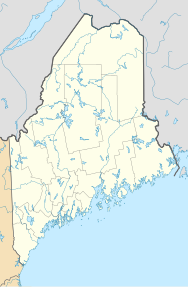Robbinston, Maine
| Robbinston, Maine | |
|---|---|
| Town | |

John N.M. Brewer House
|
|
| Location within the state of Maine | |
| Coordinates: 45°4′36″N 67°8′26″W / 45.07667°N 67.14056°W | |
| Country | United States |
| State | Maine |
| County | Washington |
| Area | |
| • Total | 33.74 sq mi (87.39 km2) |
| • Land | 28.19 sq mi (73.01 km2) |
| • Water | 5.55 sq mi (14.37 km2) |
| Elevation | 217 ft (66 m) |
| Population (2010) | |
| • Total | 574 |
| • Estimate (2012) | 566 |
| • Density | 20.4/sq mi (7.9/km2) |
| Time zone | Eastern (EST) (UTC-5) |
| • Summer (DST) | EDT (UTC-4) |
| ZIP code | 04671 |
| Area code(s) | 207 |
| FIPS code | 23-63275 |
| GNIS feature ID | 0582697 |
Robbinston is a town in Washington County, Maine, United States. The population was 574 at the 2010 census.
According to the United States Census Bureau, the town has a total area of 33.74 square miles (87.39 km2), of which, 28.19 square miles (73.01 km2) of it is land and 5.55 square miles (14.37 km2) is water. It is situated 35 miles (56 km) northeast of Machias, 16 miles (26 km) north of Lubec and 12 miles (19 km) south of Calais.
Robbinston is in Washington County, the easternmost of the United States. As it was settled, the areas, or "Plantations" were numbered, and then became villages and cities. It was named for Edward H. and Nathaniel J. Robbins who received a land grant for the area on October 21, 1786, and became the third and fourth family settled there. A post office was established by 1796, and Robbinston was incorporated on February 18, 1811.
The area near Robbinston was first settled by the French explorer Pierre de Monts from 1604-5 and then abandoned when the colony lost 36 people that first winter. That island, once called De Mont's Island, then the Neutral Island, is now the St. Croix Island International Historic Site. It marks the boundary between the United States and Canada as set out by treaty in 1783. Traces of the fort were first excavated in 1798, then the St. Croix Lighthouse was installed in 1856 at the head of Passamaquoddy Bay where it meets the St. Croix River. It now has seven life-sized historical statues as part of the park walk.
The river is 3 miles (5 km) wide separating Robbinston from the town of St. Andrews, New Brunswick, Canada. Still saltwater, the tidal range is 27.5 feet (8.4 m). Because of the abundance of wood, much of the early industry centered around shipbuilding. For example, in 1856, 17 vessels, ranging from 100 to 1000 tons each, were built at Robbinston. When steam-powered ships arrived, Robbinston returned to fishing and farming potatoes, which escaped the blight found in warmer areas. The granite quarry in Red Beach also was a local industry. The seven lakes and streams in Robbinston boasted pickerel, trout, perch and salmon.
...
Wikipedia

